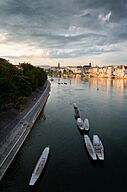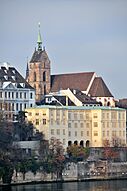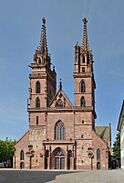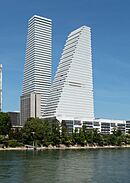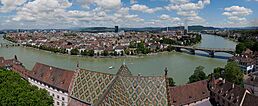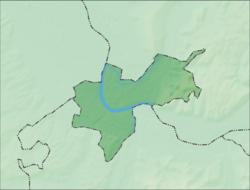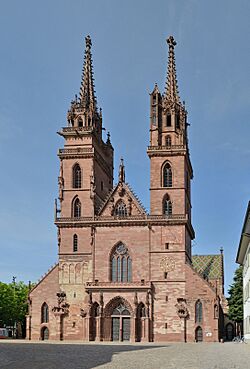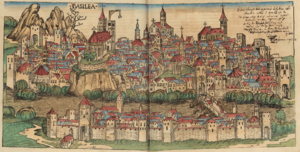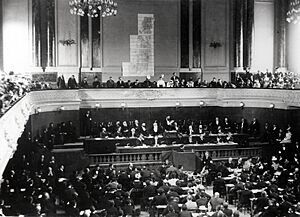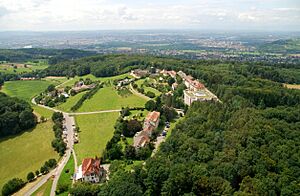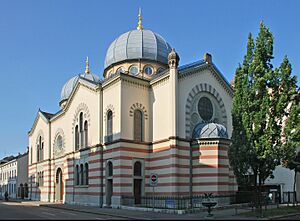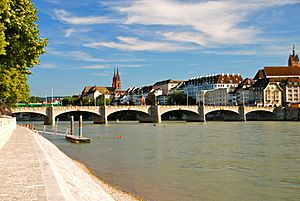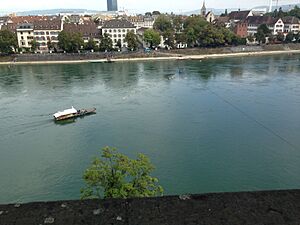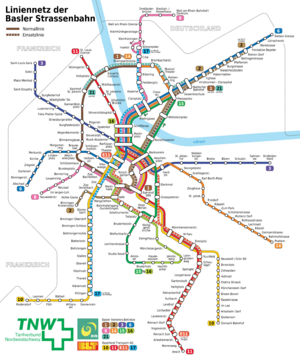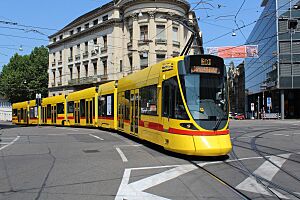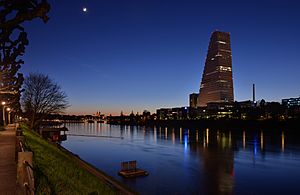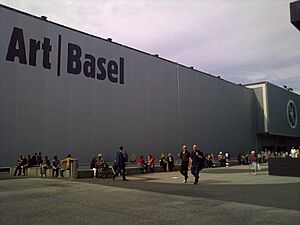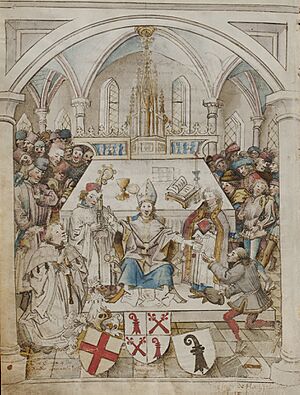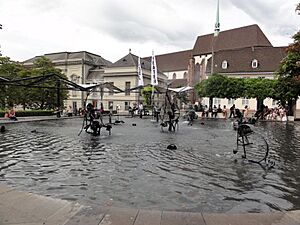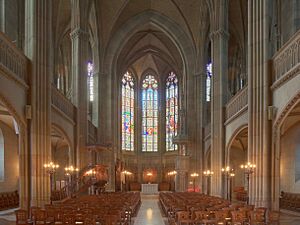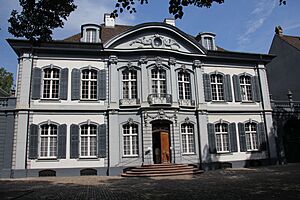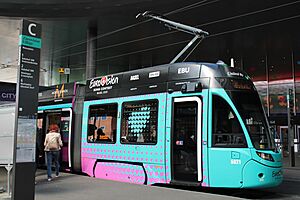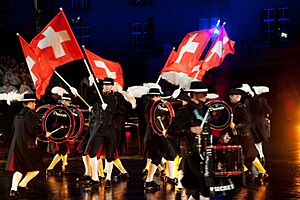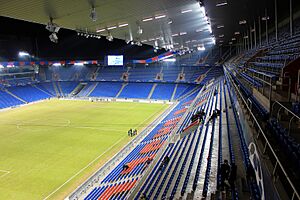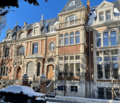Basel facts for kids
Quick facts for kids
Basel
Basle |
|||
|---|---|---|---|
|
Municipality
|
|||
|
Rhine with Middle Bridge in background
Old building of the University of Basel (below)
Basel Minster
Roche Tower and Roche Tower 2
Panorama with Rhine, Messeturm, Roche Tower, and Wettsteinbrücke
|
|||
|
|||
| Country | Switzerland | ||
| Canton | Basel-Stadt | ||
| Area
Lua error in Module:Wd at line 1575: attempt to index field 'wikibase' (a nil value).
|
|||
| • Total | Lua error in Module:Wd at line 1,575: attempt to index field 'wikibase' (a nil value). km2 (Formatting error: invalid input when rounding sq mi) | ||
| Elevation
(Barfüsserkirche)
|
261 m (856 ft) | ||
| Highest elevation
(Wasserturm Bruderholz)
|
366 m (1,201 ft) | ||
| Lowest elevation
(Rhine shore, national border at Kleinhüningen)
|
244.75 m (802.99 ft) | ||
| Population
(2018-12-31)Lua error in Module:Wd at line 1575: attempt to index field 'wikibase' (a nil value).
|
|||
| • Total | Lua error in Module:Wd at line 1,575: attempt to index field 'wikibase' (a nil value). | ||
| Demonyms | German: Basler(in), French: Bâlois(e), Italian: Basilese, Romansh: Basilean(a) | ||
| Time zone | UTC+01:00 (Central European Time) | ||
| • Summer (DST) | UTC+02:00 (Central European Summer Time) | ||
| Postal code(s) |
4000
|
||
| SFOS number | Lua error in Module:Wd at line 1575: attempt to index field 'wikibase' (a nil value). | ||
| Surrounded by | Allschwil (BL), Hégenheim (FR-68), Binningen (BL), Birsfelden (BL), Bottmingen (BL), Huningue (FR-68), Münchenstein (BL), Muttenz (BL), Reinach (BL), Riehen (BS), Saint-Louis (FR-68), Weil am Rhein (DE-BW) | ||
| Website | SFSO statistics |
||
Basel is a vibrant city in northwestern Switzerland, located right on the Rhine river. It is Switzerland's third-largest city, after Zurich and Geneva, with over 177,000 people living in the city itself.
Many people consider Basel to be the cultural heart of Switzerland. It is famous for its many museums, including the Kunstmuseum Basel, which opened in 1661 and is the world's first public art collection. Basel is also home to Art Basel, a very important international art fair.
The University of Basel, founded in 1460, is Switzerland's oldest university. Over centuries, Basel has been a safe place for famous thinkers like Erasmus of Rotterdam and Friedrich Nietzsche. Today, Basel is a major center for the chemical and pharmaceutical industries, with big companies like Novartis and Roche based here.
Basel is also known for important discoveries and achievements. In 1734, a famous math problem called the 'Basel problem' was solved here. Famous people like tennis star Roger Federer were born in Basel or have strong connections to the city.
The official language in Basel is German, but people mostly speak Basel German, a local dialect. In 2019, Basel was ranked as the tenth most liveable city in the world.
Contents
Name
The name Basel first appeared as Basilia around 237 AD. This name likely came from a personal name, Basilius, or meant "estate of Basilius."
Another idea is that it came from basilica, which means a public or church building. However, this word usually refers to buildings from the 4th or 5th century, later than when Basilia was first recorded.
Because the name sounds similar, the mythical creature basilisk became a symbol of the city. You can see it on Basel's heraldic supporter since 1448, on coins, and in many decorations.
The old French spelling Basle was used in English for a while, but now Basel is more common, matching the official German spelling.
History
Early Beginnings
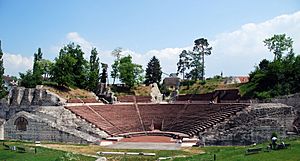
People lived near the Rhine knee as early as the 5th century BC. Around 200 BC, a village of the Raurici tribe existed where Basel is today. Later, a fortified settlement was built on the site of the Basel Minster.
The Romans built a fort here in the 1st century AD. The area became part of the Roman province of Germania Superior. The Roman Senator Lucius Munatius Plancus is traditionally seen as Basel's founder. In the late 4th century, Basilia was mentioned as a Roman military fort along the Rhine.
In 406 AD, the Alemanni Germanic tribes crossed the Rhine and settled in the area. Basel slowly grew around the old Roman fort in the 6th and 7th centuries. It became more important than the older Roman city of Augusta Raurica. Basel even started making its own coins in the 7th century.
In the 8th century, Basel became the seat of a bishop. The first cathedral was built around 806 AD, on the site of the Roman fort. This was later replaced by a new structure in 1019.
Basel was destroyed by the Magyars in 917. After being rebuilt, it became part of Upper Burgundy and then joined the Holy Roman Empire in 1032.
Rule by Prince-Bishops
From 999 AD until the Protestant Reformation, Basel was ruled by Prince-Bishops. In 1019, the building of the cathedral of Basel began.
In the 11th and 12th centuries, Basel grew into a medieval city. The main market was first mentioned in 1091. City walls were built around 1100. The first mayor was recorded in 1253. In 1225, the first bridge across the Rhine was built, which helped the city grow. For many centuries, this was the only permanent bridge over the Rhine between Lake Constance and the sea. The city's first guild (a group of skilled workers) was formed in 1226.
Conflicts between the bishops and the citizens started in the mid-13th century. By the late 14th century, the city was mostly independent, even though it still officially followed the bishops. The House of Habsburg tried to control the city, causing a split among Basel's citizens.
The Black Death arrived in Basel in 1348. Sadly, some people blamed the Jewish community, and many Jews were executed in 1349. The 1356 Basel earthquake destroyed much of the city.
A riot in 1376, called Böse Fasnacht, led to some deaths. The city was fined and placed under Habsburg control. To become free, Basel joined the Swabian League of Cities in 1385. Basel then gained full independence from both the bishop and the Habsburgs and began to expand its territory around 1400.
The Baselstab
The unique symbol of Basel's coat of arms is a bishop's crozier (a hooked staff). This symbol, called the Baselstab, first appeared in the 12th century. It became a symbol for the Basel diocese. In 1385, the city started using the Baselstab in black as its own coat of arms, while the red Baselstab represented the bishop.
In the 15th century, Basel became a very important place for Western Christianity during the Council of Basel (1431–1449). In 1459, Pope Pius II founded the University of Basel. Famous people like Erasmus of Rotterdam later taught there. Around the same time, the new skill of printing was brought to Basel by people who learned from Johann Gutenberg.
Joining the Swiss Confederation
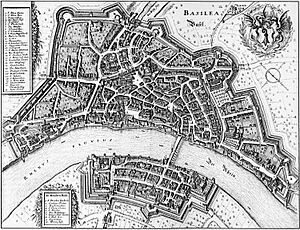
Basel stayed neutral during the Swabian War of 1499. The Treaty of Basel (1499) ended this war and helped separate Switzerland from the Holy Roman Empire.
On June 9, 1501, Basel joined the Swiss Confederation as its eleventh canton. Basel was important because of its location, its good relationships with other cities, and its control over grain imports. The agreement for Basel to join said that it should remain neutral in conflicts between other cantons and offer to help solve problems.
In 1529, Basel became a Protestant city under Johannes Oecolampadius. The bishop's seat moved away, but the bishop's crook remained the city's symbol. For centuries, a few wealthy families, known as the "Daig", became very influential in the city.
In 1536, the first edition of Institutes of the Christian Religion by John Calvin, a key book for Calvinist beliefs, was published in Basel. In 1543, De humani corporis fabrica, the first book on human anatomy, was also printed in Basel by Andreas Vesalius.
The Amerbach Cabinet, a large collection of artifacts and books, was bought by Basel in 1661. It became the first public art museum in the world. The famous Bernoulli family, including mathematicians like Jakob Bernoulli and Daniel Bernoulli, were from Basel. The mathematician Leonhard Euler was also born in Basel and studied there.
Modern Times
In 1833, after some political unrest, the countryside area separated from the city of Basel, forming the half-canton of Basel-Landschaft. Between 1861 and 1878, the old city walls were removed.
On July 3, 1874, Switzerland's first zoo, the Zoo Basel, opened in the city.
In 1897, the first World Zionist Congress was held in Basel. This important meeting happened in Basel ten times, more than in any other city.
In 1967, the people of Basel voted to buy three paintings by Pablo Picasso to keep them in the local art museum. This made Basel the first city where citizens democratically decided to buy art for a public institution. Picasso was so touched that he gave the city three more paintings.
Basel as a Meeting Place
Basel has often been a place for important international meetings and peace talks. The Treaty of Basel (1499) ended the Swabian War. The Peace of Basel in 1795 ended parts of the French Revolutionary Wars.
More recently, the World Zionist Organization held its first congress here in 1897. In 1912, the (Socialist) Second International held a special congress in Basel because of the Balkan Wars. In 1989, the Basel Convention was signed here. This agreement aims to stop harmful waste from being sent from rich countries to developing nations.
Geography and Climate
Location
Basel is in Northwestern Switzerland and is seen as the capital of this region. It is very close to where the borders of Switzerland, France, and Germany meet. Basel even has suburbs in France and Germany. As of 2016, the Basel area was the third-largest in Switzerland, with over 541,000 people. The larger metropolitan area, called the Trinational Eurodistrict of Basel, includes parts of neighboring countries and had about 829,000 people in 2007.
Topography
Basel covers an area of about 23.91 square kilometers (9.23 sq mi). About 4% of this land is used for farming, and 3.7% is covered by forests. Most of the city, about 86.4%, is built up with buildings and roads. Rivers and lakes make up about 6.1% of the area.
Climate
Basel has an oceanic climate, meaning it has cool to cold, often cloudy winters and warm, humid summers.
On average, Basel has 118.2 days of rain or snow each year, receiving about 842 mm (33.1 in) of precipitation. May is usually the wettest month, with about 98 mm (3.9 in) of rain over 11.7 days. February is the driest month, with about 45 mm (1.8 in) of precipitation over 8.4 days.
| Climate data for Basel (Binningen), elevation: 316 m (1,037 ft), 1991–2020 normals, extremes 1901–present | |||||||||||||
|---|---|---|---|---|---|---|---|---|---|---|---|---|---|
| Month | Jan | Feb | Mar | Apr | May | Jun | Jul | Aug | Sep | Oct | Nov | Dec | Year |
| Record high °C (°F) | 19.0 (66.2) |
22.0 (71.6) |
25.2 (77.4) |
30.5 (86.9) |
33.5 (92.3) |
38.4 (101.1) |
39.0 (102.2) |
38.7 (101.7) |
35.0 (95.0) |
29.6 (85.3) |
21.9 (71.4) |
20.6 (69.1) |
39.0 (102.2) |
| Mean daily maximum °C (°F) | 5.1 (41.2) |
7.1 (44.8) |
11.8 (53.2) |
16.2 (61.2) |
20.0 (68.0) |
23.7 (74.7) |
25.8 (78.4) |
25.3 (77.5) |
20.7 (69.3) |
15.4 (59.7) |
9.2 (48.6) |
5.7 (42.3) |
15.5 (59.9) |
| Daily mean °C (°F) | 2.2 (36.0) |
3.2 (37.8) |
7.0 (44.6) |
10.7 (51.3) |
14.6 (58.3) |
18.2 (64.8) |
20.2 (68.4) |
19.7 (67.5) |
15.4 (59.7) |
11.1 (52.0) |
6.0 (42.8) |
2.9 (37.2) |
10.9 (51.6) |
| Mean daily minimum °C (°F) | −0.5 (31.1) |
−0.1 (31.8) |
2.6 (36.7) |
5.5 (41.9) |
9.5 (49.1) |
13.1 (55.6) |
14.9 (58.8) |
14.8 (58.6) |
11.0 (51.8) |
7.6 (45.7) |
3.2 (37.8) |
0.4 (32.7) |
6.8 (44.2) |
| Record low °C (°F) | −24.2 (−11.6) |
−23.8 (−10.8) |
−14.8 (5.4) |
−6.3 (20.7) |
−2.7 (27.1) |
1.1 (34.0) |
5.1 (41.2) |
3.6 (38.5) |
−1.3 (29.7) |
−5.5 (22.1) |
−11.0 (12.2) |
−20.9 (−5.6) |
−24.2 (−11.6) |
| Average precipitation mm (inches) | 48 (1.9) |
45 (1.8) |
50 (2.0) |
64 (2.5) |
98 (3.9) |
87 (3.4) |
89 (3.5) |
88 (3.5) |
70 (2.8) |
74 (2.9) |
65 (2.6) |
65 (2.6) |
842 (33.1) |
| Average snowfall cm (inches) | 7 (2.8) |
7 (2.8) |
4 (1.6) |
1 (0.4) |
0 (0) |
0 (0) |
0 (0) |
0 (0) |
0 (0) |
0 (0) |
2 (0.8) |
8 (3.1) |
29 (11) |
| Average precipitation days (≥ 1.0 mm) | 9.1 | 8.4 | 8.9 | 9.3 | 11.7 | 10.6 | 10.1 | 10.2 | 8.5 | 10.4 | 10.0 | 11.0 | 118.2 |
| Average snowy days (≥ 1.0 cm) | 2.8 | 2.1 | 1.1 | 0.2 | 0.0 | 0.0 | 0.0 | 0.0 | 0.0 | 0.1 | 0.7 | 2.3 | 9.3 |
| Average relative humidity (%) | 81 | 76 | 69 | 67 | 71 | 70 | 68 | 71 | 77 | 82 | 83 | 82 | 75 |
| Mean monthly sunshine hours | 64 | 85 | 135 | 167 | 186 | 212 | 235 | 217 | 160 | 107 | 65 | 54 | 1,687 |
| Percent possible sunshine | 28 | 34 | 40 | 45 | 44 | 48 | 54 | 55 | 48 | 36 | 28 | 27 | 43 |
| Source 1: MeteoSwiss | |||||||||||||
| Source 2: KNMI | |||||||||||||
Politics
Basel is the capital of the Swiss half-canton of Basel-Stadt.
Canton and City Government
The canton of Basel-Stadt includes three municipalities: Riehen, Bettingen, and the city of Basel itself. The political structures for the city and the canton are the same.
City Quarters
The city of Basel is divided into 19 quarters. These are grouped into Grossbasel (Greater Basel) and Kleinbasel (Lesser Basel).
- Grossbasel (Greater Basel):
- 1 Altstadt Grossbasel
- 2 Vorstädte
- 3 Am Ring
- 4 Breite
- 5 St. Alban
- 6 Gundeldingen
- 7 Bruderholz
- 8 Bachletten
- 9 Gotthelf
- 10 Iselin
- 11 St. Johann
- Kleinbasel (Lesser Basel):
- 12 Altstadt Kleinbasel
- 13 Clara
- 14 Wettstein
- 15 Hirzbrunnen
- 16 Rosental
- 17 Matthäus
- 18 Klybeck
- 19 Kleinhüningen
Executive Council
Basel's executive branch, called the Executive Council (Regierungsrat), has seven members. They are elected for four-year terms. The president of the council is elected by public vote. The council meets in the red Town Hall on the central Marktplatz. This building was built between 1504 and 1514.
As of 2021, the Executive Council includes members from the Social Democratic Party (SP), LDP, Green Liberals (glp), and Christian Democratic Party (CVP).
Parliament
The city's and canton's parliament, the Grand Council of Basel-Stadt (Grosser Rat), has 100 members. These members are elected every four years. Unlike the Executive Council, members of the Grand Council are not full-time politicians; they are paid for their attendance. Anyone living in Basel who can vote can be elected to the parliament. The Grand Council also meets in the Town Hall.
The last election was on October 25, 2020, for the 2021–2025 term. The Grand Council includes members from various parties, such as the Social Democratic Party, Green Party, Liberal-Democratic Party, Swiss People's Party, Green Liberal Party, The Liberals, Christian Democratic People's Party, and Evangelical People's Party.
International Connections
Sister Cities and Partners
Basel has several sister cities and partner regions around the world:
- Massachusetts, USA (since 2002)
- Shanghai, China (since 2007)
- Toyama Prefecture, Japan (since 2009)
- Miami Beach, USA (since 2011)
- Abidjan, Ivory Coast (since 2021)
- Seoul, South Korea (since 2022)
Basel also has a partner city:
- Rotterdam, Netherlands (since 1945)
Demographics
As of 2021, the canton of Basel (which is slightly larger than the city) has a population of 201,971. About 36.9% of these residents are foreign nationals.
Between 1999 and 2009, Basel's population changed slightly, with more people moving in than leaving, and a small decrease due to births and deaths.
In 2000, about 35.2% of the people living in Basel were born there. Another 26.9% were born elsewhere in Switzerland, and 32.3% were born outside Switzerland.
In 2008, the population of Swiss citizens decreased slightly, while the foreign population increased. Overall, Basel's population grew by 0.9% in 2008.
In 2000, there were 86,371 households in Basel, with an average of 1.8 people per household. About half of the households had only one person.
Languages
In 2000, most people in Basel spoke German (77.8%). Italian was the second most common language (5.4%), followed by French (2.6%).
Religions
According to the 2000 census, about 25.2% of the population was Roman Catholic, and 23.5% belonged to the Swiss Reformed Church. Other Christian churches, Orthodox churches, and the Christian Catholic Church of Switzerland also had members. About 7.43% of the population was Muslim, and 0.80% was Jewish. A significant portion of the population (31.41%) did not belong to any church or were atheist.
Infrastructure
Transport
Basel's airport, EuroAirport Basel Mulhouse Freiburg, handles airfreight. Goods also arrive in Basel by ship along the Rhine, connecting to ocean-going ships at the port of Rotterdam.
Port
Basel has Switzerland's only cargo port. This port is important for moving goods along the Rhine river, which connects to the sea.
Air Travel
The EuroAirport Basel Mulhouse Freiburg is unique because it is operated by both France and Switzerland, even though it is entirely on French land. The airport has separate sections for French and Swiss travelers.
Railways
Basel was the first Swiss city to have a railway station and has always been an important rail hub. Three main railway stations serve the Swiss, French, and German networks. The Swiss (Basel SBB) and French (Bâle SNCF) stations are in the same building, separated by customs. The German Basel Badischer Bahnhof is on the northern side of the city. All stations are connected to the local tram and bus network. Basel's regional trains, called the Basel S-Bahn, connect the city to places in Switzerland, France, and Germany.
Most long-distance trains, like EC, TGV, and ICE, stop at Basel SBB station. The ICE also stops at Basel Bad Bf. A new high-speed ICE line from Karlsruhe to Basel was finished in 2008. The TGV Rhine-Rhône line, opened in 2011, reduced travel time from Basel to Paris to about 3 hours.
Roads
Basel is located on the A3 motorway.
Five bridges connect Greater and Lesser Basel across the Rhine:
- Schwarzwaldbrücke (built 1972)
- Wettsteinbrücke (current bridge built 1998, original 1879)
- Mittlere Rheinbrücke (Middle Rhine bridge, current bridge built 1905, original 1225 as the first Rhine bridge)
- Johanniterbrücke (built 1967)
- Dreirosenbrücke (built 2004, original 1935)
Ferries
There are also four unique reaction ferry boats that cross the Rhine. These ferries are attached to a cable high above the river. The ferryman angles the boat so the river's current pushes it across. This means they don't need any outside energy source!
Public Transport
Basel has a large public transportation system, including an extensive tram network. Basel's tramway is the largest in Switzerland in terms of track length.
The green trams and buses are run by Basler Verkehrs-Betriebe (BVB). The yellow buses and trams are run by Baselland Transport (BLT) and connect to areas in the nearby Baselland canton. BVB also works with French and German transit authorities for bus lines across the border. The Basel Regional S-Bahn commuter rail network is operated by SBB, SNCF, and DB.
Border Crossings
Basel is at the meeting point of France, Germany, and Switzerland. It has many road and rail crossings. Since Switzerland joined the Schengen Area in 2008, there are no longer immigration checks at these crossings. However, customs checks are still done because Switzerland is not part of the European Union Customs Union.
Health
As the largest city in Northwest Switzerland, Basel has many public and private health centers. These include the Universitätsspital Basel and the Universitätskinderspital Basel (Children's Hospital). The Swiss Tropical and Public Health Institute is also located here.
Energy
Basel is a leader in Switzerland's goal to greatly reduce energy use by 2050. Many projects are underway to research and develop new technologies for a "2000-watt society". This includes buildings designed to save energy, electricity from renewable energy sources, and vehicles that use natural gas or biogas.
In 2002, a law was passed requiring all new flat roofs to be greened, making Basel a world leader in green roofs. This helps save energy.
Economy
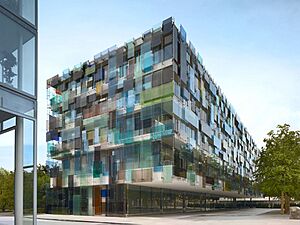
Basel is one of Switzerland's most active economic regions. As of 2016, Basel had an unemployment rate of 3.7%. In 2018, most workers (80.6%) were in the service industry, while 19.3% worked in manufacturing or construction.
In 2008, there were over 130,000 full-time jobs in Basel. Many of these jobs were in manufacturing, transportation, finance, and healthcare. Basel attracts many workers from outside the city and even from other countries.
The first Roche Tower, designed by Herzog & de Meuron, opened in 2015 and became the tallest building in Switzerland at 178 meters (584 ft). Roche Tower-2, opened in 2022, is even taller with 50 floors, making it Switzerland's tallest building. Basel also has Switzerland's third tallest building, the Basler Messeturm (105 m / 344 ft), and its tallest tower, the St. Chrischona TV tower (250 m / 820 ft).
Industries
The chemical industry and pharmaceutical industry are very important in Basel. Companies like Novartis, Syngenta, Hoffmann-La Roche, and Actelion have their main offices here. Basel is also a major European center for Biotech and Biopharmaceuticals, with many smaller start-up companies.
Banking
Banking is also a key part of Basel's economy:
- UBS AG has central offices in Basel.
- The Bank for International Settlements (BIS) is located in Basel. It's often called the "central banker's bank." Switzerland was chosen for the BIS because it is an independent and neutral country with excellent railway connections. The BIS is owned by its member central banks and has special legal protections. The Basel Committee on Banking Supervision, which makes recommendations for banks worldwide, also meets here.
- Basel is home to the Global Infrastructure Basel Foundation, which works on financing sustainable infrastructure projects.
Airlines
Swiss International Air Lines, Switzerland's national airline, has its headquarters at the EuroAirport Basel-Mulhouse-Freiburg near Basel.
Media
Basler Zeitung (BaZ) and bz Basel are the local newspapers. Telebasel is the local TV station. The German-speaking Swiss Radio and Television SRF also has offices in Basel. Academic publishers like Birkhäuser and Karger are based here.
Trade Fairs
Basel hosts many important trade shows. Art Basel is the world's most important fair for modern and contemporary art, held every June. Baselworld, a major watch and jewelry show, used to attract many visitors but is now discontinued. Swissbau (for construction) and Igeho (for hotels and catering) are other important fairs. The Swiss Sample Fair was Switzerland's largest and oldest consumer fair.
Education
Basel has a long history of achievements in mathematics. Famous mathematicians like Leonhard Euler and the Bernoulli family studied and taught here for centuries. The Swiss Mathematical Society was founded in Basel in 1910.
In 2000, about 34.7% of the population had finished upper secondary education, and 16.6% had completed higher education (university or a technical college).
In 2010, 11,912 students attended the University of Basel. Many students from other places also come to Basel for school.
Universities
Basel is home to Switzerland's oldest university, the University of Basel, founded in 1460. Many famous people, including Erasmus, Paracelsus, Daniel Bernoulli, Leonhard Euler, Friedrich Nietzsche, and Carl Gustav Jung, worked there. The University of Basel is considered one of the top 90 educational institutions worldwide.
In 2007, the ETH Zurich (Swiss Federal Institute of Technology Zürich) opened its Department of Biosystems Science and Engineering (D-BSSE) in Basel.
Basel also hosts several academies of the Fachhochschule Nordwestschweiz|Fachhochschule NW (FHNW), including academies for art and design, music, and business.
Schools
In 2005, over 16,900 students attended Basel's public schools, from kindergarten to lower secondary school. By 2010, more than half of all students spoke a language other than German as their first language.
Basel has five public high schools (gymnasiums), each with different specializations like visual design, science, languages, music, or economics. These schools prepare students for university. There are also vocational schools and higher vocational schools for specialized training.
International Schools
Because many foreign nationals live in Basel, the city has several international schools. These include the Academia International School, École Française de Bâle, International School Basel, and SIS Swiss International School.
Libraries
Basel has at least 65 libraries. Some of the largest include the Universitätsbibliothek Basel (main university library) and the libraries of various colleges. In 2008, these libraries held over 8.4 million books and other media, and over 1.7 million items were borrowed.
Culture
Main Sights
The red sandstone Münster is one of the most important late-Romanesque/early Gothic buildings in the Upper Rhine region. It was badly damaged in the 1356 earthquake but was rebuilt and restored. A memorial to Erasmus is inside the Münster. The City Hall, built in the 16th century, is on the Market Square and has beautiful murals.
Basel also has many buildings designed by famous architects. These include the Beyeler Foundation by Renzo Piano and buildings in the nearby Vitra complex by architects like Zaha Hadid and Frank Gehry. Basel also features buildings by Mario Botta and Herzog & de Meuron, who are known for designing the Tate Modern in London and the Bird's Nest in Beijing. Basel received the Wakker Prize in 1996 for its well-preserved architecture.
Heritage Sites
Basel has many heritage sites of national importance. These include the entire Old Town of Basel and many specific buildings and collections.
- Churches and monasteries
Old Catholic Prediger Kirche, Bischofshof, former Carthusian House of St Margarethental, Catholic Church of St Antonius, Lohnhof (former Augustinians Collegiate Church), Mission 21, Archive of the Evangelisches Missionswerk Basel, Münster of Basel (cathedral), Reformed Elisabethenkirche, Reformed Johanneskirche, Reformed Leonhardskirche, Reformed Martinskirche, Reformed Pauluskirche, Reformed Peterskirche, Reformed St. Albankirche with cloister and cemetery, Reformed Theodorskirche, Synagogue at Eulerstrasse 2.
- Secular buildings
Badischer Bahnhof (German Baden's railway station) with fountain, Bank for International Settlements, Blaues Haus (Reichensteinerhof), Bruderholzschule, Brunschwiler Haus, Bahnhof Basel SBB (Swiss railway station), Bürgerspital, Café Spitz (Merianflügel), Coop Schweiz company's central archive, Depot of the Archäologischen Bodenforschung des Kanton Basel-Stadt, former Gallizian Paper Mill and Swiss Museum of Paper, former Klingental-Kaserne with Klingentaler Kirche, Fasnachtsbrunnen (fountain), Feuerschützenhaus, Fischmarktbrunnen (fountain), Geltenzunft, Gymnasium am Kohlenberg (St Leonhard), Hauptpost, Haus zum Raben, Hohenfirstenhof, Holsteinerhof, Markgräflerhof, Mittlere Rhein Brücke (Central Rhine Bridge), Stadtcasino, Ramsteinerhof, Rathaus (town hall), Rundhof building of the Schweizerischen Mustermesse, Safranzunft, Sandgrube, Schlösschen Gundeldingen, Schönes Haus and Schöner Hof, Wasgenring school house, Seidenhof, Spalenhof, Spiesshof, city walls, Townhouse, Weisses Haus, Wildt'sches Haus, Haus zum Neuen Singer, Wolfgottesacker, Zerkindenhof.
- Archaeological sites
The Celtic Settlement at Gasfabrik, Münsterhügel and Altstadt (historical city, late La Tène and medieval settlement).
- Museums, archives and collections
Basel is known as the Cultural Capital of Switzerland.
Some of its many museums, archives, and collections include:
- Anatomical Museum of the University Basel
- Berri-Villen and Museum of Ancient Art Basel and Ludwig Collection
- Basel Paper Mill (Basler Papiermühle)
- Beyeler Foundation
- Botanical Garden Basel
- Caricature & Cartoon Museum Basel (Karikatur & Cartoon Museum Basel)
- Dollhouse Museum (Puppenhausmuseum), which has Europe's largest teddy bear collection.
- Foundation Fernet Branca in Saint-Louis, Haut-Rhin (modern art)
- Historical Museum Basel (Historisches Museum Basel)
- Kunsthalle Basel (modern and contemporary art)
- Kunstmuseum Basel, with the world's oldest public art collection.
- Monteverdi Automuseum
- Museum of Cultures Basel (Museum der Kulturen Basel), with large collections on European and non-European cultures.
- Museum of Contemporary Art (art from the 1960s to today).
- Music Museum (Musikmuseum) of the Basel Historic Museum.
- Natural History Museum of Basel (Naturhistorisches Museum Basel).
- Pharmazie-Historisches Museum der Universität Basel (Pharmacy Historical Museum).
- Poster Collection of the School for Design.
- Swiss Business Archives.
- Sculpture Hall.
- Sports Museum of Switzerland.
- Archives of the Canton of Basel-Stadt.
- UBS AG Corporate Archives.
- University Library with manuscripts and music collection.
- Zoological Garden (Zoologischer Garten).
Theatre and Music
Basel is home to the Schola Cantorum Basiliensis, founded in 1933, which is a global center for studying and performing old music. Theater Basel is known for its plays, opera, and ballet. Basel also has Switzerland's largest orchestra, the Sinfonieorchester Basel. Other orchestras like the Basel Sinfonietta and the Kammerorchester Basel are also based here. The Paul Sacher Foundation holds a major collection of music manuscripts.
In May 2004, Basel hosted the fifth European Festival of Youth Choirs. The local Basel Boys Choir hosts this festival.
Basel hosted the Eurovision Song Contest 2025 at St. Jakobshalle.
Events
Basel hosts many fairs and events throughout the year. Art Basel, a very important fair for contemporary art, takes place every June.
The Basel Carnival (Basler Fasnacht) is a huge cultural event. It's the biggest carnival in Switzerland and attracts many people. It starts at 4 AM on a winter Monday and lasts for 72 hours. During this time, almost all work in the old city stops. Fife and drum clubs parade with masks and lanterns.
The Basel Tattoo, started in 2006, is the world's second-largest military tattoo. It features a parade with an estimated 125,000 visitors and is the official military tattoo of Switzerland.
Food
Basel has its own special foods, like Basler Läckerli cookies and Mässmogge candies. Because it's where Switzerland, France, and Germany meet, Basel has a very wide variety of restaurants.
Zoo
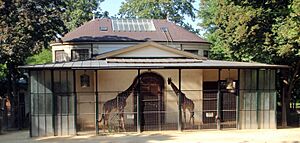
Zoo Basel is the most visited tourist attraction in Basel, with over 1.7 million visitors each year. It's also the second most visited in Switzerland.
Opened in 1874, Zoo Basel is Switzerland's oldest and largest zoo by animal count. It has had many successful animal births, including the first Indian rhinoceros and Greater flamingo born in a zoo worldwide. Forbes Travel ranked Zoo Basel as one of the fifteen best zoos in the world in 2008.
Locals lovingly call their zoo "Zolli", showing how much they care about it.
Sports
Basel has major sports venues, including a large football stadium that has received a four-star rating from UEFA. It also has a modern ice hockey arena and a sports hall.
The football club FC Basel is very successful. Basel was one of the Swiss cities that hosted the 2008 European Championships. Other football teams in Basel include BSC Old Boys and Concordia Basel.
Ice hockey is also popular in Switzerland. Basel is home to EHC Basel, an ice hockey team that plays in the third tier of the Swiss league system. They play their home games at the 6,700-seat St. Jakob Arena.
Basketball has a small but dedicated fan base. The "Birstal Starwings" are Basel's team in the top Swiss basketball league.
A large indoor tennis event, the Swiss Indoors, takes place in Basel every October. Some of the best tennis players, including Basel native Roger Federer, play here.
In July 2022, the women's water polo team WSV Basel won their 11th national championship title.
Basel GAA, a Gaelic games club, and Basel Dragons AFC, an Australian Football team, are also located in Basel.
The annual Basel Rhine Swim attracts thousands of people who swim or float in the Rhine.
The headquarters of the IHF (International Handball Federation) is located in Basel.
Notable People
Many notable people were born or grew up in Basel:
- Gaspard Bauhin (1560–1624), botanist and anatomist.
- Matthäus Merian the Elder (1593–1650), engraver.
- Jacob Bernoulli (1654–1705), mathematician.
- Johann Bernoulli (1667–1748), mathematician.
- Daniel Bernoulli (1700–1782), mathematician and physicist, known for his work in fluid dynamics.
- Leonhard Euler (1707–1783), mathematician, physicist, and astronomer.
- Jacob Burckhardt (1818–1897), historian of art and culture.
- Arnold Böcklin (1827–1901), symbolist painter.
- Friedrich Miescher (1844–1895), scientist who first isolated nucleic acid.
- Karl Barth (1886–1968), Swiss Reformed theologian.
- Arthur Cohn (born 1927), film producer and multiple Academy Award winner.
- Peter Zumthor (born 1943), architect.
- Antoine Konrad (born 1975), DJ and record producer.
- Roger Federer (born 1981), professional tennis player.
- Granit Xhaka (born 1992), professional footballer for Switzerland.
- Fina Girard (born 2001), politician and youth climate activist.
Images for kids
-
University of Basel (est. in 1460) and Martinskirche
See also
 In Spanish: Basilea para niños
In Spanish: Basilea para niños
- Tourism in Switzerland
- Rhine knee


